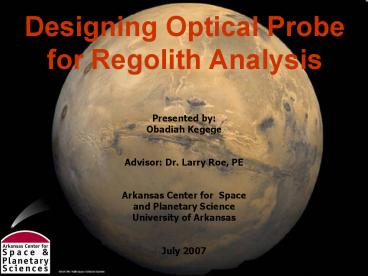Gullies on Mars. Mars is the fourth planet from the Sun - PowerPoint PPT Presentation
1 / 13
Title:
Gullies on Mars. Mars is the fourth planet from the Sun
Description:
Gullies on Mars. Mars is the fourth planet from the Sun, referred as the red planet ... Mars rovers have excavated on the surface and collected samples to study ... – PowerPoint PPT presentation
Number of Views:391
Avg rating:3.0/5.0
Title: Gullies on Mars. Mars is the fourth planet from the Sun
1
Designing Optical Probe for Regolith Analysis
- Presented by
- Obadiah Kegege
- Advisor Dr. Larry Roe, PE
- Arkansas Center for Space
- and Planetary Science
- University of Arkansas
- July 2007
2
Outline
- Introduction
- Approach
- Experimental Equipment
- Preliminary Results
- Summary and Conclusion
3
Introduction
- Mars is the fourth planet from the Sun, referred
as the red planet - Martian atmosphere is composed primarily of
carbon dioxide with small amounts of other gases - The surface temperatures range from -140
C (-220 F) to 20 C (68 F) - Evidence of features resembling gullies,
riverbeds, and erosions suggest that water or
some fluid existed on the surface - Mars rovers have excavated on the surface and
collected samples to study regolith - disturbs
the sedimentary layering which hinders
exploration and full information extraction - This work focuses on designing an optimum system
for sampling Martian regolith - explore Mars
without disturbing sedimentary layering.
Channel/riverbed on Mars
Gullies on Mars
4
Approach
- First, we experimentally investigate the force
required to insert different dimensions of
sampling spikes into regolith - Next, use the optimum dimensions and design the
shaft/penetrator with linear array of near-IR
illuminators within a spectral range of 0.5 to 5
µm - Real-time mineralogical and chemical profiling as
a function of depth for undisturbed sediments. - This proposed system shall be applicable to any
surface that has regolith or icy properties
including Moon and asteroids.
Mars rover (Figure obtained from 1 )
Probe to be pushed below the surface by rovers
with minimum force
5
Approach
Overview of simple probe
- The regolith resistance to probe
penetration can be expressed as
- where
Total force acting on the probe (tip sleeve)
Probe surface area (tip sleeve )
6
Experimental Equipment
- We have two measurement setups
- constant velocity system
- constant force system
Regolith Two different types of regolith have
been used in these experiments JSC Mars-1
feldspar, Ti-magnetite, with minor olivine,
pyroxene and glass JSC Mars-2 45 clay, 45
basalt, 10 iron oxide
Constant velocity penetration test
Constant force penetration test
7
Experimental Equipment
- To create relationship between regolith strength
and depth - (1) Velocity Mode
- Electric actuator pushes the probe down at
certain speed to a designated depth and stops
there - At each depth level, the load cell will read the
regolith strength (penetration force) - (2) Constant Force Mode
- Pneumatic actuator pushes the probe down at
certain constant force until balanced by the
resistance strength from the regolith. - The LVDT will measure the penetrating depth
- Computer program will measure the time between
depth intervals
8
Preliminary Results Constant Velocity
- It takes 210 N to insert a 19.05 mm cylindrical
spike to 152 mm into JSC Mars-1 - 79 N to insert a 12.70 mm cylindrical spike into
JSC Mars-1 - 6 N removing 19.05 mm spike
- 3 N removing 12.70 mm spike
- It takes about 1/10 of the force applied in JSC
Mars-1 to insert the same spikes into JSC Mars-2.
9
Preliminary Results Constant Velocity
- 19.05 mm diameter spike
- 19 degrees tip angle 313N
- 12 degrees tip angle 130N
- 12.70 mm diameter spike
- 19 degrees tip angle 145N
- 12 degrees tip angle 123N
- Reducing the spike tip angle reduces the
penetration force for both 19.05 mm and 12.70 mm
spikes.
10
Preliminary Results - Constant Force
JSC Mars-1 Data
Spirit/Opportunity rover on NASA's Mars mission
weigh 1800 N (397 lb)
JSC Mars-2 Data
11
Summary and Conclusion
- Preliminary penetration force experiments show
that regolith resistance is dependent on regolith
texture/composition - Possible to characterize the layering of
undisturbed regolith by measured strength at
different depths - The mechanical penetration of the probe will
characterize regolith strength versus depth, and
the near IR illuminators (under design by R.
Pilgrim) would obtain mineralogical composition
at each depth. - The ultimate goal is to design and build a
simple, low cost, light weight, low power
regolith sampling probe
12
Future Work
- Collaboration and experiments using the simulated
Martian environmental chamber to facilitate the
development of a real-time autonomous regolith
sampling sensor system. - Acknowledgements
- I would like to acknowledge support from Space
Center grant and faculties in the Arkansas Center
for Space and Planetary Sciences
13
References
- Rick Ulrich, Derek Sears, Matt Leftwich, Larry
Roe, Vincent Chevrier, Walter Graupner, Fiber
Optic Spectral Array on a Regolith Probe for
Surface and Sub-Surface Mineralogical Profiling
Optical Probe for Regolith Analysis, Arkansas
Center for Space Planetary Sciences, University
of Arkansas, June 2006 - Peter M. Cao, Ernest L. Hall, Soil sampling
sensor system on a mobile robot, Proceedings of
SPIE, Intelligent Robots and Computer Vision XXI
Algorithms, Techniques, and Active Vision, pp.
304-310, October 2003 - Jeffrey E. Herrick, Tim L. Jones, "A dynamic
cone penetrometer for measuring soil penetration
resistance", Soil Science Society of America
Journal 661320-1324 , 2002 - Bradley D.A, Seward D.W., Developing real-time
autonomous excavation-the LUCIE story,
Proceedings of the 34th IEEE Conference on
Decision and Control, 1995































